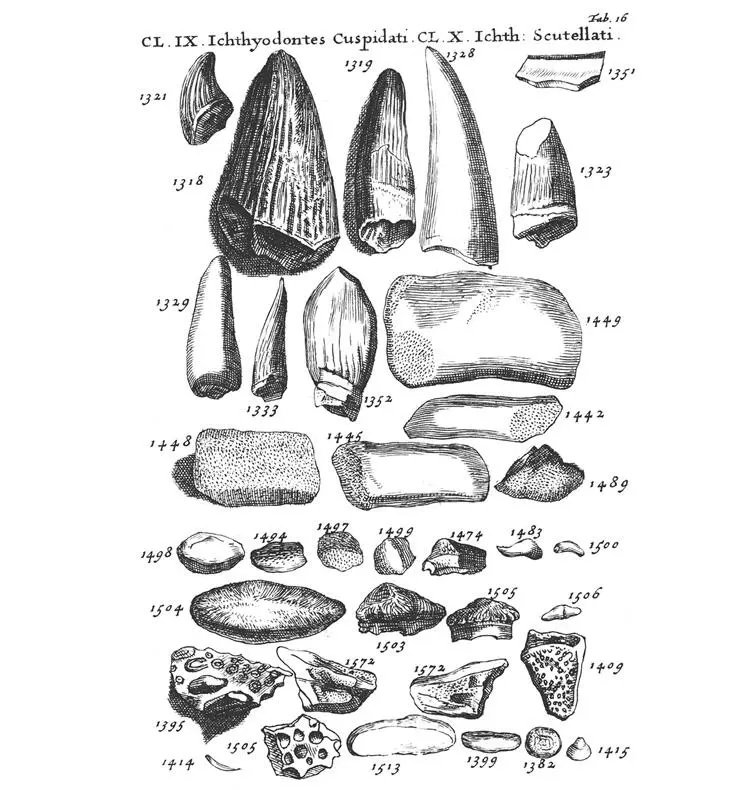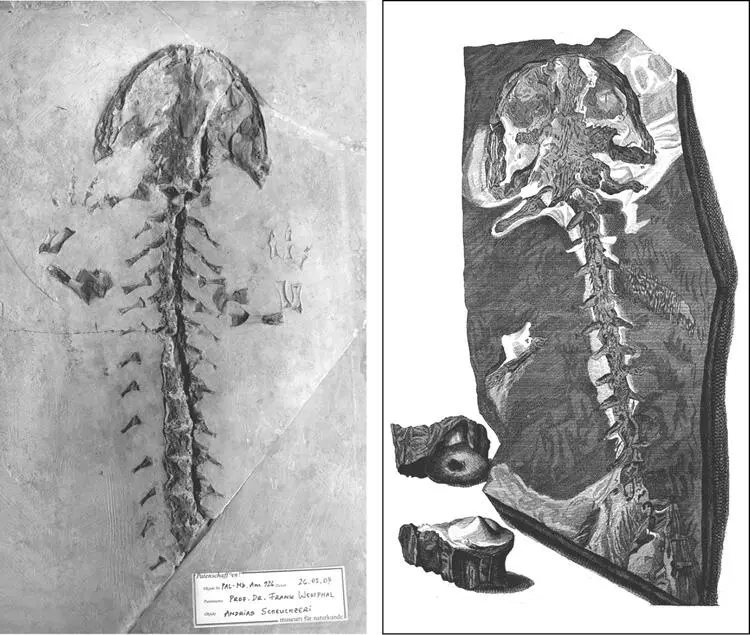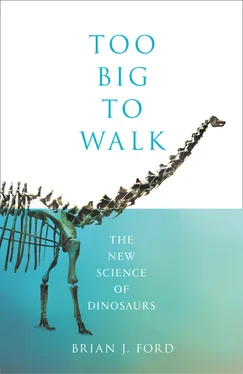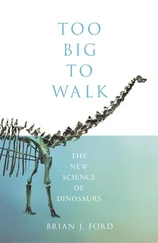
In 1697 Edward Lhuyd engraved his pioneering studies of fossils, and was encouraged by John Ray to publish them. Failing to find a publisher, he solicited subscribers and eventually had enough money to publish Lithophylacii Brittannici Ichnographia in 1699.

Robert Darwin, ancestor of Charles, discovered this skeleton of Plesiosaurus dolichodeirus in 1718. It was displayed in the local vicarage as the bones of a sinner who had died in the great flood, before Darwin recognized it as a fossil.
Then, in 1719, palæontology was quietly born. A clergyman scientist named William Stukeley, a studious man from a legal family, set out for the first time to develop the systematic study of archæological remains. Stukeley came from Holbeach, in Lincolnshire, and was a friend of Isaac Newton. Because of his scientific accomplishments, he was elected a Fellow of the Royal Society and in 1718 became the first Secretary of the Society of Antiquaries in London. The great English prehistoric monuments at Avebury and Stonehenge had long been sites of cultural interest, and indeed Stukeley himself was fascinated by the Druids, but neither site had been academically investigated until Stukeley showed interest in their origins. He examined them systematically, and this is how he came to be regarded as a father of archæology. In 1718 Stukeley visited the Reverend John South, Rector of Elston, near Newark on the boundary with Nottinghamshire, some 50 miles (80 km) from his home. In the nearby quarries of Fulbeck, Blue Lias rock was being mined and a fossil plesiosaur came to light. It was taken home by South, and became known locally as the Elston crocodile. The owner of Elston Hall was Robert Darwin, himself an FRS, and destined to become the great-grandfather of Charles Darwin. It was hoped that Stukeley could examine the ancient skeleton and find out more about it. Stukeley’s account of the discovery is meticulous:
There are Sixteen Vertebræ of the Back and Loyns very plain and distinct, with their Processes and intermediate Cartilages, Nine whole or partial Ribs of the Left-side, the Os Sacrum, Ilium in situ, and two Thigh-Bones displac’d a little, the Beginnings of the Tibia and Fibula of the Right-Leg; on one Corner there seem to be the Vestigia of a Foot with four of the five Toes, and a little way off an entire Toe, now left perfect in the Stone – there are no less than Eleven Joints of the Tail, and the Cartilages between them of a White Colour distinguishable from the rest. Sir Hans Sloan has a Fish-Sceleton, amongst his immense Treasure of Curiosities, found near this Place, given by the Duke of Rutland.

Left: When Johann Jakob Scheuchzer of Zürich was shown this fossilized salamander, he believed it to be the remains of a preserved human victim of the Noahic flood. It is in the collections of the Museum für Naturkunde in Berlin.
Right: Scheuchzer’s published account, Homo diluvii testis (A Flood Man), appeared in 1726. Conventional interpretations of these fossils (like Robert Darwin’s ‘Elston crocodile’) were taken as tangible evidence of biblical realities.
Stukeley discussed all this with his Royal Society friends, and his curious specimen was taken to London for inspection by the Fellows. An account of the discovery was presented to a meeting of the Fellows by Robert Darwin on December 11, 1718, and Stukeley was subsequently invited to publish a formal account in the Society’s journal. This was the first scientific description of a prehistoric reptile skeleton, which in 1824 was named Plesiosaurus dolichodeirus , and today the remains are on display at the Natural History Museum in London. Stukeley’s paper was a landmark; the era of palæontology was beginning to dawn.24
The swiss naturalist, Johann Scheuchzer, wrote extensively of his travels and also commented on fossils. He was shown a remarkable relic, a clearly preserved skeleton excavated from a quarry in Baden, and published it in 1726. Scheuchzer’s interpretation, just as we would expect at the time, was that this represented a human victim of the flood, trapped forever in its stony embrace and preserved for modern man to contemplate his fleeting fate on Earth.25
Twenty years later, the first vertebrate fossils to be excavated in the U.S. were discovered by Charles III Le Moyne, the second Baron de Longueuil, when he was exploring the course of the Ohio River in 1739. Le Moyne, who later became Governor of Montreal, had an active military career fighting against both the British and the Iroquois, and did much exploring for the burgeoning fur trade. This part of the Ohio River is swampy, rich with lush vegetation and dotted with mineral pools and hot springs that bubble from the strata seams beneath. Near the river bank Le Moyne discovered some huge bones. Nobody knew what they were, though eventually they were identified as belonging to a mammoth. For decades, the fossils that Le Moyne excavated were known simply as the ‘Ohio Animal’. The site in Kentucky is now open to the public as Big Bone Lick State Park, and the welcome signs today proclaim it as the ‘Birthplace of American Vertebrate Paleontology’. The bones excavated from this region are far more recent than dinosaurs; those magnificent monsters existed between 250 and 66 million years ago, whereas the mammalian fossils Le Moyne had found are less than 80,000 years old, and some date back only 12,000 years.26
These became the first American fossils to be formally described when Jean-Étienne Guettard published a summary of recent discoveries in palæontology. Guettard would become one of the pioneers of this emergent discipline.27
In 1780 Guettard went on to publish the first mineralogical map of France, which delineated where valuable resources might be found, and which was the first publication to demonstrate the volcanic origins of the Auvergne district of central France. The book also included maps of sites of interest to fossil collectors and was recognized as a pioneering publication in the emerging science of geology.28
Meanwhile, in England in 1755, a naturalist in Oxford named Joshua Platt made a momentous discovery: three ‘enormous’ vertebræ and then a femur that, when freed from the surrounding rock, weighed 220 pounds (100 kg). Platt had a lifelong interest in fossils, and at the time was studying the nature of belemnites. Colossal bones were not something he had previously experienced, so he sent them on to a Quaker botanist, Peter Collison, who was known for his broad interests in natural history and traded with America. Nothing more was done to investigate them – and the specimens have since disappeared. Fossils were attracting a wider audience and, when his paper on belemnites was published in 1764, Platt began with these words:
The public hath of late been agreeably entertained with description of many curious Fossils, discovered in different parts of this kingdom; but very little hath been offered with a view to ascertain their origin and formation; a point of much greater importance to a curious mind, than the most accurate descriptions, or the neatest delineations.
This was a key point: describing fossils was all very well, and drawing them, though intrinsically useful, did not reveal what they actually were. For his paper, Platt broke open the belemnites and neatly described what he found within. This was a pioneering attempt to explore the anatomy of fossils, a discipline that became a mainstay of palæontology in the centuries that followed.29
Читать дальше















